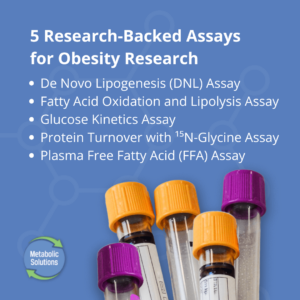
11 Nov The Top Research-Backed Assays for Obesity Research
When you’re designing your clinical trial, you know that every detail in your study protocol can influence the outcome.
One of the most critical factors?
The choice of assays used to measure metabolic biomarkers.
The right assays provide precision, dynamic insights, and reliable data that can shape everything from therapeutic strategies to regulatory submissions.
But using assays that lack sensitivity or aren’t matched to your research goals can lead to gaps in your data, missed efficacy signals, or even regulatory challenges.
Using advanced techniques such as stable isotope labeling, you can now track key biomarkers with exceptional precision, enabling dynamic, repeatable assessments of metabolic pathways. This approach allows for a more targeted understanding of obesity’s underlying mechanisms.
Whether you’re tracking glucose kinetics, lipid metabolism, or key hormonal changes, selecting assays tailored to your research can transform how effectively you measure outcomes and make informed decisions.
In this article, we’ll take a close look at two categories of research-backed assays for obesity research: the first will be assays that we specifically provide to our customers, and the second will be additional assays to consider when planning your research.
In the spirit of transparency, we believe Metabolic Solutions studies are ideal for:
Metabolic Function Studies: our assays are ideal for in-depth analysis of metabolic processes, such as glucose kinetics, lipid metabolism, and protein turnover. They provide detailed insights into how nutrients and hormones are processed in the body, making them essential for studies that require precise, kinetic data.
Energy Expenditure and Fat Metabolism: Use these assays when studying energy balance and fat utilization in obesity research. The De Novo Lipogenesis and Fatty Acid Oxidation assays are particularly useful for understanding how obesity affects lipid synthesis and fat breakdown.
Other assays (we do not provide these) are available for:
Hormonal and Inflammatory Markers: Leptin, Adiponectin, and CRP assays are valuable when assessing the hormonal and inflammatory profiles of individuals with obesity. These are crucial for understanding systemic factors, such as inflammation and appetite regulation, that contribute to metabolic diseases.
Cardiovascular Risk Assessment: The Lipid Profile and CRP assays are essential for evaluating cardiovascular health, as dyslipidemia and chronic inflammation are significant risk factors for heart disease in obese populations.
While for the purpose of this article, we sort them into two categories, the tests are not necessarily mutually exclusive. There are circumstances when you might combine the assays, including:
Comprehensive Obesity Research: When studying obesity as a multifactorial condition, you might use both Metabolic Solutions and other assays. For example, combining Metabolic Solutions’ metabolic function assays with hormonal and inflammatory markers allows for a holistic understanding of how metabolic dysfunction, hormonal imbalances, and inflammation interplay.
Evaluating Therapeutic Interventions: In clinical trials, both sets of assays may be necessary to fully evaluate the impact of a treatment. Metabolic Solutions assays can track the metabolic effects, while other assays can monitor changes in inflammation, hormone levels, and cardiovascular risk.
This combined approach provides a robust framework for understanding obesity and developing more effective interventions.
Let’s take a closer look at obesity-related biomarker assays.
What Are Obesity-Related Biomarker Assays?
Obesity-related biomarker assays are critical tools in understanding the biological mechanisms underlying obesity and its associated conditions. These assays focus on measuring specific substances—such as hormones, proteins, and genetic markers—that provide insights into how obesity contributes to metabolic disorders like diabetes, cardiovascular disease, and chronic inflammation.
Metabolic Solutions Assays
Metabolic Solutions’ stable isotope-based assays are cutting-edge tools that utilize non-radioactive, naturally occurring isotopes like ¹³C and deuterium to trace and quantify various metabolic processes in the human body. These assays provide unparalleled precision in measuring metabolic flux, including glucose metabolism, lipid synthesis, protein turnover, and liver function.
Our clients choose our stable isotope-based assays in pre-clinical and clinical trials for a number of reasons:
Non-Invasive and Safe: Stable isotopes are non-toxic and safe for human studies, making these assays suitable for repeated measures in clinical trials without causing harm or discomfort to participants.
High Sensitivity and Precision: These assays can detect very small changes in metabolic activity, providing dynamic and accurate data essential for understanding the impact of treatments or interventions on metabolic health.
Dynamic Insights: By measuring how metabolic processes change over time, researchers can gain a deeper understanding of how drugs or therapies affect the body, informing dosage adjustments and treatment efficacy.
Regulatory-Ready Data: All assays are conducted in GLP-compliant labs, ensuring the data generated is suitable for regulatory submissions to bodies like the FDA, accelerating the drug development process.
Our stable isotope assays enable an understanding of key metabolic pathways, making them invaluable for assessing drug efficacy, optimizing clinical trial design, and developing effective therapies for metabolic disorders.

Here are five of the research-backed assays we provide that are relevant to obesity research:
1. De Novo Lipogenesis (DNL) Assay
A De Novo Lipogenesis (DNL) assay uses stable isotope tracers, such as deuterated water (D2O) or labeled glucose, to measure the conversion of carbohydrates into fatty acids within the liver. This process occurs when excess dietary carbohydrates are converted into fat, contributing to fat storage.
This assay is critical for obesity research because the DNL pathway becomes more active in individuals with obesity, leading to increased fat accumulation and metabolic complications like insulin resistance and fatty liver disease. By quantifying DNL, researchers can evaluate how different dietary interventions or pharmacological treatments affect fat synthesis. The DNL assay provides key insights into metabolic health and helps identify strategies to mitigate fat accumulation and improve metabolic outcomes in obese populations.
2. Fatty Acid Oxidation and Lipolysis Assay
A fatty acid oxidation and lipolysis assay utilizes stable isotope-labeled fatty acids to measure the rate at which fatty acids are broken down and used for energy in the body. This assay specifically tracks lipid metabolism, providing insights into how the body mobilizes and oxidizes fat.
This assay is essential in obesity research to understand how lipid metabolism is disrupted in individuals. Impaired fat oxidation and excessive lipolysis are associated with metabolic conditions like insulin resistance and fatty liver disease. By assessing these metabolic processes, researchers can evaluate the effectiveness of treatments designed to improve fat utilization and reduce lipid accumulation, contributing to a better understanding of obesity-related metabolic dysfunction.
3. Glucose Kinetics Assay
A glucose kinetics assay employs stable isotope-labeled glucose to evaluate how glucose is produced, metabolized, and disposed of in the body. It provides precise measurements of glucose flux, which are critical for understanding insulin sensitivity and the regulation of blood sugar levels.
This assay is fundamental in metabolic research focused on obesity, as impaired glucose metabolism is a hallmark of insulin resistance and type 2 diabetes. By measuring glucose kinetics, researchers gain insights into how obesity influences glucose regulation and can assess the efficacy of interventions aimed at improving insulin sensitivity and metabolic health. This assay is particularly valuable in studies investigating the progression of metabolic syndrome and the impact of therapeutic strategies on glucose homeostasis.
4. Protein Turnover with ¹⁵N-Glycine Assay
A protein turnover assay using ¹⁵N-glycine measures the rates of protein synthesis, breakdown, and overall nitrogen balance in the body. It provides a comprehensive view of how proteins are metabolized, which is crucial for understanding muscle maintenance and metabolic health.
This assay is especially relevant in obesity research because muscle metabolism significantly influences energy expenditure. Obesity often disrupts protein metabolism, leading to muscle loss and altered energy balance. By tracking protein turnover, researchers can evaluate the impact of obesity on muscle function and explore the effectiveness of interventions aimed at preserving muscle mass and improving metabolic outcomes. This assay is vital for studies focused on the role of muscle health in obesity and related metabolic disorders.
5. Plasma Free Fatty Acid (FFA) Assay
The plasma free fatty acid (FFA) assay measures the concentration of unbound fatty acids in the plasma. FFAs are released from adipose tissue into the bloodstream and play a crucial role in energy metabolism.
Elevated levels of plasma FFAs are commonly observed in individuals with obesity and are strongly associated with the development of insulin resistance and non-alcoholic fatty liver disease (NAFLD). High plasma FFA levels contribute to metabolic dysfunction by impairing insulin signaling and promoting fat accumulation in the liver.
The plasma FFA assay is widely used in clinical trials to assess the impact of interventions such as dietary changes, pharmacological treatments, or weight-loss programs on fatty acid metabolism and insulin sensitivity. This assay provides essential data for understanding how elevated FFAs contribute to metabolic diseases and evaluating the effectiveness of treatments aimed at reducing metabolic risk factors.
Examples of Additional Obesity-Related Assays Metabolic Solutions Doesn’t Provide
While Metabolic Solutions specializes in metabolic function assays, there are other important assays available to assess hormonal and inflammatory markers in obesity research, which we don’t provide.
1. Leptin Assay
A leptin assay measures the concentration of leptin, a hormone primarily secreted by adipose (fat) tissue, which regulates energy balance and appetite. In healthy individuals, leptin signals the brain to suppress hunger when energy stores are sufficient. However, in individuals with obesity, leptin levels are often elevated due to leptin resistance, where the body becomes less responsive to these signals, leading to continued hunger and excessive fat storage.
This assay is crucial in preclinical and clinical trials aimed at understanding metabolic dysfunctions associated with obesity. Elevated leptin levels serve as a key biomarker for leptin resistance, offering insights into the progression of obesity-related diseases such as type 2 diabetes and cardiovascular conditions. By measuring leptin, researchers can evaluate the effectiveness of therapeutic interventions aimed at improving leptin sensitivity and metabolic health.
2. Adiponectin Assay
An adiponectin assay measures the levels of adiponectin, a hormone secreted by adipose (fat) tissue that plays a key role in glucose regulation and fatty acid metabolism. Adiponectin enhances the body’s ability to process glucose and break down fats, making it crucial for maintaining metabolic balance.
Decreased adiponectin levels are commonly observed in individuals with obesity, and low levels are closely associated with insulin resistance, metabolic syndrome, and an increased risk of developing type 2 diabetes and cardiovascular disease.
This assay is particularly valuable in preclinical and clinical trials focused on metabolic health, as it provides critical insights into the relationship between adipose tissue function and metabolic disorders. By monitoring adiponectin levels, researchers can evaluate how interventions, such as weight-loss treatments or insulin-sensitizing drugs, impact metabolic function, offering a valuable tool for tracking therapeutic efficacy in metabolic research.
3. C-Reactive Protein (CRP) Assay
The CRP assay measures levels of C-reactive protein, a marker of systemic inflammation produced by the liver in response to inflammation in the body. Elevated CRP levels are often found in individuals experiencing chronic inflammation, a common feature of metabolic disorders such as obesity and cardiovascular disease.
Elevated CRP levels are strongly associated with chronic low-grade inflammation, which is a significant contributor to obesity-related complications and increased cardiovascular risk. This assay is widely used in clinical trials and metabolic research to assess inflammation levels and monitor how therapeutic interventions, such as anti-inflammatory treatments or lifestyle changes, impact systemic inflammation. CRP serves as an important biomarker for identifying individuals at higher risk of developing cardiovascular diseases, making it a valuable tool for researchers aiming to understand and mitigate inflammation-related health risks in obesity and metabolic syndromes.
4. Insulin Assay
The insulin assay measures circulating insulin levels in the blood, providing insights into the body’s ability to regulate glucose. Insulin is a hormone produced by the pancreas that enables cells to absorb glucose from the bloodstream for energy.
Elevated fasting insulin levels are a key indicator of insulin resistance, a condition where the body’s cells become less responsive to insulin. This is a common feature in individuals with obesity and serves as a precursor to type 2 diabetes and other metabolic disorders.
The insulin assay is critical in clinical trials and metabolic research for diagnosing insulin resistance early, evaluating the effectiveness of interventions such as weight-loss treatments or insulin-sensitizing therapies, and preventing the progression to diabetes. Tracking insulin levels helps researchers better understand metabolic dysfunction and how therapeutic interventions impact glucose regulation.
5. Lipid Profile (Cholesterol, LDL, HDL, Triglycerides) Assay
The lipid profile assay measures levels of total cholesterol, low-density lipoprotein (LDL), high-density lipoprotein (HDL), and triglycerides in the blood. This comprehensive panel provides insights into a person’s lipid metabolism and overall cardiovascular health.
Dyslipidemia—characterized by elevated triglycerides and LDL (often referred to as “bad cholesterol”) and reduced HDL (“good cholesterol”)—is a common metabolic disturbance in individuals with obesity. These lipid imbalances significantly increase the risk of developing cardiovascular disease.
The lipid profile assay is widely used in clinical trials and research to assess the impact of interventions such as lifestyle modifications, weight-loss treatments, or lipid-lowering medications on improving lipid balance. Monitoring these parameters is essential for understanding how therapies influence cardiovascular risk and overall metabolic health.
6. Interleukin-6 (IL-6) Assay
The IL-6 assay measures levels of interleukin-6, a pro-inflammatory cytokine involved in the body’s immune response. IL-6 plays a critical role in inflammation and can influence metabolic processes.
Elevated IL-6 levels are commonly found in individuals with obesity and are associated with chronic inflammation, which contributes to insulin resistance and increases the risk of developing type 2 diabetes.
The IL-6 assay is a valuable tool in clinical research for assessing the degree of inflammation in metabolic disorders and tracking how interventions, such as anti-inflammatory therapies or lifestyle changes, affect inflammatory responses. Monitoring IL-6 provides important insights into the link between inflammation and metabolic dysfunction, making it crucial for trials focused on obesity-related inflammation and its impact on metabolic health.
7. Tumor Necrosis Factor-Alpha (TNF-α) Assay
The TNF-α assay measures levels of tumor necrosis factor-alpha, a pro-inflammatory cytokine primarily produced by adipose (fat) tissue. TNF-α plays a significant role in regulating inflammation and immune responses within the body.
Elevated TNF-α levels are frequently observed in individuals with obesity and are strongly linked to chronic inflammation and insulin resistance—key factors in the development of type 2 diabetes and other metabolic disorders. The TNF-α assay is used in clinical trials and research to assess the extent of inflammation and its contribution to metabolic dysfunction. By tracking TNF-α levels, researchers can evaluate how therapeutic interventions—such as anti-inflammatory drugs or lifestyle modifications—affect inflammation and metabolic health, making it an important tool in studies focused on obesity-related inflammation and insulin resistance.
8. Ghrelin Assay
The ghrelin assay measures levels of ghrelin, a hormone produced primarily in the stomach that stimulates appetite and plays a key role in regulating hunger and energy balance. Ghrelin levels typically rise before meals and decrease after eating, signaling the body’s need for food.
In individuals with obesity, ghrelin levels may be altered, often decreasing, which can disrupt hunger regulation and contribute to imbalances in energy expenditure. The ghrelin assay is vital in clinical trials focused on understanding how appetite control mechanisms are affected in obesity and how interventions—such as weight-loss treatments or appetite-regulating drugs—impact ghrelin secretion. Monitoring ghrelin levels provides valuable insights into the hormonal regulation of appetite and energy balance, making it an important tool for researchers studying the mechanisms driving obesity and its metabolic effects.
Benefits of Metabolic Disorder Assays
Metabolic disorder assays provide a number of benefits when developing new therapies, including:
Early Detection of Metabolic Disorders
Metabolic disorder assays are essential in preclinical and clinical trials, providing critical insights that help identify conditions before they progress into more severe health issues. Early detection of disorders such as metabolic syndrome enables timely interventions, preventing complications like heart disease and stroke. With 1 in 3 adults in the United States affected by metabolic syndrome, frequent and accurate screening through these assays is crucial in managing long-term health risks and accelerating research on preventive therapies.
Timely Interventions and Treatments
Once metabolic disorders are identified through these assays, early interventions—whether lifestyle changes or pharmaceutical treatments—can be introduced. In clinical trials, this data allows researchers to assess how quickly an intervention can affect metabolic biomarkers, such as insulin sensitivity or lipid profiles.
These early insights are vital for understanding the effectiveness of therapeutic candidates in reducing the risk of further complications, leading to more successful outcomes in trials. For instance, newborn screening programs rely on early detection of metabolic dysfunction to significantly improve health outcomes from infancy, offering long-term benefits in preventing disease progression.
Monitoring Treatment Efficacy in Trials
Metabolic disorder assays are crucial tools for monitoring the efficacy of interventions throughout the course of a clinical trial. Researchers can track dynamic changes in key biomarkers, such as insulin sensitivity or lipid profiles, over multiple time points, providing clear data on how patients are responding to a therapy. This allows trial designers to adjust dosages or modify treatment protocols in real-time to improve the study’s outcomes. The ability to detect early shifts in treatment efficacy ensures that data-driven clinical decisions are made, improving the trial’s success rate.
Flexible Treatment Adjustments
The data gathered from metabolic disorder assays enable researchers to make necessary adjustments to treatment regimens during trials. If an intervention is not yielding the expected results or causing adverse effects, assay data can be used to pivot the study’s direction. This adaptive approach is especially valuable in trials focusing on complex metabolic conditions, where treatment must be tailored to the individual patient’s needs. Leveraging precise assay data helps trial designers optimize therapeutic outcomes, ultimately supporting personalized medicine.
Cost-Effectiveness in Clinical Trials
Accurate metabolic disorder assays can reduce trial costs by providing early insights that reduce the need for more invasive or expensive interventions later in the study. By identifying metabolic dysfunction early and monitoring its progression, clinical trials can avoid costly complications, hospitalizations, or advanced interventions that may arise from unchecked conditions. Efficient management through these assays reduces the financial burden on healthcare systems, making them indispensable tools in cost-effective clinical research.
Enhancing Genetic Understanding in Preclinical Trials
By integrating genetic testing with metabolic disorder assays, researchers gain a comprehensive view of a subject’s predisposition to metabolic diseases and how genetic factors influence the progression of these conditions. In preclinical trials, this multifaceted approach allows for the exploration of genetic markers alongside biochemical data, enabling more precise therapeutic targeting. This dual approach aids in personalized treatment strategies, improving the likelihood of success in human trials.
Supporting Long-Term Health Management in Clinical Trials
In clinical settings, metabolic disorder assays provide critical data that helps track key biomarkers over the course of long-term studies. Continuous monitoring of metabolic changes ensures that patients are receiving the most effective interventions and allows researchers to gather data on long-term therapeutic efficacy. This proactive approach improves trial outcomes by identifying early signs of metabolic dysfunction, enabling trial sponsors to refine their study protocols based on reliable data.
Mastering the use of metabolic disorder assays in preclinical and clinical trials empowers researchers to develop personalized treatments, improve study design, and make informed, data-driven decisions that support better health outcomes. These assays are indispensable tools for advancing research on metabolic disorders and developing effective therapies for obesity-related conditions.
Tips for Selecting Obesity-Related Assays
Tip #1: Consider Study Objectives
Understanding your research goals is critical, particularly in the context of preclinical and clinical trials. First, outline your primary objectives—whether you are focusing on insulin resistance, inflammatory markers, or hormonal regulation. The selected assay should align with these goals to ensure meaningful results.
For example, if your objective is to assess insulin resistance, using a fasting insulin assay would provide relevant data. On the other hand, if your study focuses on inflammation pathways, choose assays like C-reactive protein (CRP) or Interleukin-6 (IL-6), both commonly associated with obesity-induced inflammation. Additionally, ensure the assays can track changes over time for longitudinal studies, crucial in clinical trials where the impact of treatments must be evaluated.
Tip #2: Evaluate Assay Sensitivity
In clinical trials, assay sensitivity is key to accurately measuring biomarker concentrations, particularly when dealing with obesity-related conditions. High sensitivity ensures that even small fluctuations in biomarkers, such as adiponectin or ghrelin, are detected, providing insights into metabolic shifts during treatment.
For example, assays like those used to measure adiponectin must balance sensitivity and specificity to ensure accurate detection within complex biological samples. In trials where precise estimates of biomarker levels directly influence treatment protocols, selecting an assay with high sensitivity is essential to drive meaningful outcomes.
Tip #3: Cost-Effectiveness
Research budgets are often limited, especially in clinical trials. When selecting assays, it’s important to weigh the upfront costs against the long-term value of the data produced. While individual biomarker assays may appear more cost-effective initially, using multiplex assays that measure several biomarkers simultaneously can provide better value over time, reducing the total cost across multiple trial phases.
Moreover, the choice of assay should consider not just the initial cost, but also expenses related to reagents, equipment, and data interpretation. In clinical trials, where large datasets must be collected and analyzed, opting for cost-effective assays without compromising on data quality ensures efficient resource allocation.
Tip #4: Complexity and Time Requirements
The complexity of an assay can significantly affect project timelines in a clinical setting. Simpler assays, like ELISA, may provide faster results, but more complex methodologies, such as mass spectrometry, offer greater depth and precision in understanding obesity biomarkers.
In trials where rapid decision-making is essential, it’s important to choose assays that balance scientific rigor with time efficiency. Consider the preparation time, runtime, and overall workflow when selecting an assay, ensuring it aligns with the project’s timeline while delivering the necessary level of detail for regulatory submissions.
Tip #5: Integration with Existing Research
The assays selected should integrate seamlessly with the broader research framework in your clinical trial. Consider what assays are commonly used in existing studies within your area of interest, as aligning with established methodologies allows for better data comparison and contributes to the ongoing scientific dialogue.
By choosing assays that complement existing research models, your trial can contribute valuable insights to the field, while benefiting from validated methodologies. Leveraging resources such as Assessment Tools in Obesity can guide you in selecting assays that are aligned with current research standards.
Wrapping It Up
Hormonal and protein-based assays uncover vital insights into metabolic disorders, while adipose tissue analysis and in vitro models simulate obesity conditions. Selecting the right assays is key, depending on your study’s focus, sensitivity needs, and budget. These techniques are essential for advancing your understanding of obesity and metabolic health.
Planning trials begins with choosing assays that not only provide precise, reliable data but also minimize the burden on study participants. Non-invasive assays, such as breath tests or stable isotope tracing, offer a clear advantage by allowing you to collect dynamic data over multiple time points without the discomfort of invasive procedures. This approach is particularly valuable in longitudinal obesity studies where tracking changes over time is critical.
Metabolic Solutions specializes in non-invasive, dynamic testing solutions that deliver continuous insights into metabolic processes. Our advanced assays offer GLP-compliant, regulatory-ready data, tailored to your trial’s needs, without compromising participant comfort or data quality.
By integrating our non-invasive methods into your research, you can optimize your study outcomes while maintaining the highest scientific standards.
Let’s discuss how Metabolic Solutions’ dynamic, non-invasive assays can enhance the precision of your obesity research and streamline your clinical trials.


